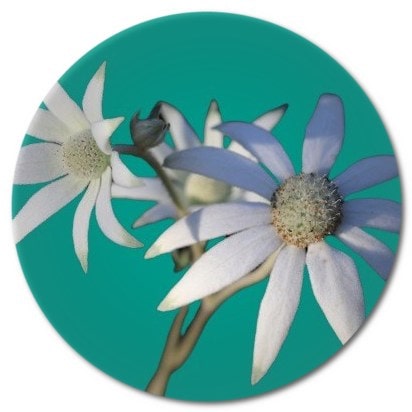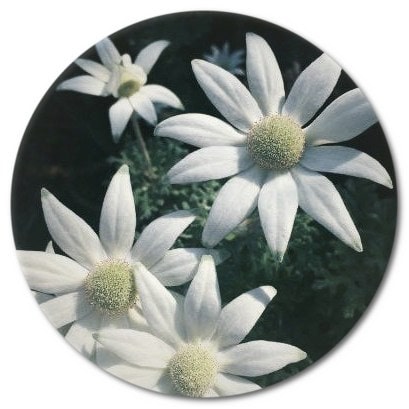The flannel flower, scientifically known as Actinotus helianthi, is native to eastern Australia and is known for its distinctive appearance, with white or cream-colored flowers and soft, velvety bracts. The flannel flower continues to be appreciated for its beauty, cultural significance, and contribution to Australia’s unique flora. Whether found in its natural habitat or cultivated in gardens, it remains a symbol of Australia’s rich botanical diversity.
We list some of the information you wonder about the flannel flower below.
- Indigenous Australian Use:
- Indigenous Australian communities have a deep connection with native flora, including the flannel flower. The plant has been used traditionally for various purposes, including as a food source and for its medicinal properties.
- Botanical Documentation:
- The flannel flower was officially described and documented by early European botanists and explorers. One notable figure is Sir Joseph Banks, the botanist who accompanied Captain James Cook on his first voyage to the Pacific in the late 18th century. Banks made significant contributions to the documentation of Australian flora, including the flannel flower.
- Cultural and Symbolic Significance:
- The flannel flower holds cultural and symbolic significance in Australian flora. Its distinctive appearance, with soft and textured bracts resembling flannel or felt, makes it a unique and cherished plant.
- Botanical Interest:
- Over the years, the flannel flower has attracted attention from botanists, horticulturists, and plant enthusiasts due to its unique features and its role in Australian ecosystems.
- Cultivation and Gardening:
- The flannel flower has become a popular choice in native gardens and landscaping projects in Australia. Its distinctive appearance and cultural significance contribute to its appeal as a native ornamental plant.
- Conservation Efforts:
- Like many native Australian plants, the flannel flower faces threats from habitat loss and environmental changes. Conservation efforts are underway to protect and preserve the species and its natural habitats.
- Artistic Representations:
- The flannel flower has inspired various forms of art, including Indigenous Australian art, botanical illustrations, and contemporary artistic representations. Its unique texture and appearance make it a subject of interest for artists and designers.

The flannel flower continues to be appreciated for its beauty, cultural significance, and contribution to Australia’s unique flora. Whether found in its natural habitat or cultivated in gardens, it remains a symbol of Australia’s rich botanical diversity.
What is the flannel flower symbol?
The flannel flower, Actinotus helianthi, is a native Australian plant that holds cultural and symbolic significance. While the specific symbolic meanings can vary, especially within Indigenous Australian cultures, the flannel flower is generally associated with the following concepts:
- Purity and Innocence: The soft, velvety appearance of the flannel flower is often associated with qualities of purity and innocence. The delicate and pristine nature of the flower’s appearance contributes to these symbolic meanings.
- Connection to Nature and the Land: The flannel flower is an integral part of the Australian landscape, and its presence is a symbol of the unique and diverse flora found in the region. It represents a connection to the natural environment and the importance of preserving native biodiversity.
- Resilience: Like many native plants, the flannel flower has adapted to the Australian climate and environmental conditions. Its ability to thrive in various habitats symbolizes resilience and adaptability.
- Cultural Heritage: The flannel flower holds cultural significance in Indigenous Australian communities. Its traditional uses in food, medicine, and cultural practices contribute to its importance as a symbol of cultural heritage.
- Botanical Beauty: The unique and striking appearance of the flannel flower makes it a symbol of botanical beauty. Its presence in gardens, artworks, and other representations highlights its aesthetic value.
- Sensitivity and Gentleness: The delicate nature of the flannel flower’s appearance is often associated with qualities of sensitivity and gentleness. It is a reminder of the importance of approaching nature with care and respect.
- Floral Symbol of Australia: As a native Australian flower, the flannel flower is considered a symbol of the country’s diverse and unique flora. It is often featured in representations of Australian flowers and landscapes.

It’s important to note that the specific symbolic meanings of the flannel flower can vary among different Indigenous cultures and may have specific significance in particular regions or communities. Additionally, the flower’s symbolism may also be influenced by individual interpretations and cultural contexts.
What is the meaning of the flannel flower?
The meaning of the flannel flower, Actinotus helianthi, can vary based on cultural, historical, and individual perspectives. Here are some general meanings associated with the flannel flower:
- Purity and Innocence: The soft and velvety appearance of the flannel flower is often linked to qualities of purity and innocence. The pristine white or cream-colored flowers contribute to this symbolic association.
- Connection to Nature: The flannel flower is seen as a symbol of the natural environment, particularly in the context of Australia’s native flora. Its presence represents a connection to the land and the importance of preserving biodiversity.
- Cultural Significance: The flannel flower holds cultural significance, especially in Indigenous Australian communities. It has traditional uses in food, medicine, and cultural practices, contributing to its importance as a symbol of cultural heritage.
- Botanical Beauty: The unique and intricate appearance of the flannel flower makes it a symbol of botanical beauty. It is appreciated for its aesthetic qualities and is often featured in gardens and floral arrangements.
- Gentleness and Sensitivity: The delicate nature of the flannel flower’s appearance is associated with qualities of gentleness and sensitivity. It serves as a reminder of the vulnerability and beauty found in nature.
- Resilience and Adaptability: As a native Australian plant, the flannel flower symbolizes resilience and adaptability to the challenging environmental conditions of the Australian landscape.
- Floral Emblem of Australia: While not an official national floral emblem, the flannel flower is recognized as a native Australian flower and can be seen as a representation of the country’s unique and diverse flora.
It’s important to consider that the meaning of the flannel flower can also be influenced by individual interpretations, cultural contexts, and personal experiences. Additionally, Indigenous Australian cultures may have specific meanings and associations with the flannel flower that are deeply rooted in their traditions and practices.
Where does the flannel flower grow? How to care for it?
The flannel flower (Actinotus helianthi) is native to eastern Australia and is found in various habitats, including heathlands, forests, and coastal areas. When cultivating the flannel flower in a garden or landscape setting, it’s important to replicate its natural conditions. Here are guidelines on how to care for the flannel flower:
Growing Conditions:
- Climate: Flannel flowers thrive in temperate to subtropical climates. They are well-suited for regions with mild temperatures.
- Sunlight: Provide the flannel flower with full sun to partial shade. It generally prefers a location with plenty of sunlight.
- Soil: Use well-draining soil with a slightly acidic to neutral pH. Flannel flowers can tolerate a range of soil types, including sandy and loamy soils.
- Watering: Flannel flowers are adapted to tolerate dry conditions, but they benefit from regular watering, especially during dry spells. However, they do not like waterlogged soil.
Care and Maintenance:
- Pruning: Deadhead spent flowers regularly to encourage continuous blooming. Pruning can also help maintain the plant’s shape and size.
- Mulching: Apply a layer of mulch around the base of the plant to help conserve moisture and suppress weeds. Mulching is particularly beneficial in hotter climates.
- Fertilization: Flannel flowers generally don’t require heavy fertilization. A balanced, slow-release fertilizer applied in spring can support healthy growth.
- Disease and Pest Management: Flannel flowers are relatively resistant to pests and diseases. However, it’s essential to monitor for any signs of issues and address them promptly if they arise.
Propagation:
- Seeds: Flannel flowers can be propagated from seeds. Collect seeds from mature flowers and sow them in well-prepared soil. Keep the soil consistently moist until the seeds germinate.
- Division: Divide mature clumps of flannel flowers to create new plants. This is typically done in early spring.
Container Gardening:
- Containers: Flannel flowers can be grown in containers. Use a well-draining potting mix and ensure the container has drainage holes.
- Watering in Containers: Container-grown flannel flowers may need more frequent watering, especially during hot weather. Check the soil moisture regularly.
Remember that specific care requirements can vary based on local climate conditions and the specific species or cultivar of flannel flower you are growing. Always consider the specific needs of the plant and its adaptability to your region. Actinotus, flannel flower buy, flannel flower bunnings, flannel flower aboriginal name…
